Excerpts from George W. Bush’s speech on an Israel and Palestine state in June 2002
“For too long, the citizens of the Middle East have lived in the midst of death and fear. The hatred of a few holds the hopes of many hostage. The forces of extremism and terror are attempting to kill progress and peace by killing the innocent. And this casts a dark shadow over an entire region. For the sake of all humanity, things must change in the Middle East.
“It is untenable for Israeli citizens to live in terror. It is untenable for Palestinians to live in squalor and occupation. And the current situation offers no prospect that life will improve. Israeli citizens will continue to be victimized by terrorists, and so Israel will continue to defend herself…
“…A Palestinian state will never be created by terror—it will be built through reform. And reform must be more than cosmetic change, or a veiled attempt to preserve the status quo. True reform will require entirely new political and economic institutions, based on democracy, market economics and action against terrorism…
“…The world is prepared to help, yet ultimately these steps toward statehood depend on the Palestinian people and their leaders. If they energetically take the path of reform, the rewards can come quickly. If Palestinians embrace democracy, confront corruption and firmly reject terror, they can count on American support for the creation of a provisional state of Palestine…
“…I’ve said in the past that nations are either with us or against us in the war on terror. To be counted on the side of peace, nations must act…
“…If liberty can blossom in the rocky soil of the West Bank and Gaza, it will inspire millions of men and women around the globe who are equally weary of poverty and oppression, equally entitled to the benefits of democratic government…
“…This moment is both an opportunity and a test for all parties in the Middle East: an opportunity to lay the foundations for future peace; a test to show who is serious about peace and who it not. The choice here is stark and simple. The Bible says, ‘I have set before you life and death; therefore, choose life.’ The time has arrived for everyone in this conflict to choose peace, and hope, and life. Thank you very much.”
—George W. Bush, June 2002
Analysis
Although Bush gave this speech almost five years ago, the sentiments expressed in his speech heard by millions still prevail in many Americans’ minds. I asked several people (about fifteen) what their thoughts and feelings were about the Israel-Palestine/Israel-Arab conflict and all save one person perceived that Israelis have more of a right to be in the land than the Palestinians and felt that Palestinians were the ones who are primarily preventing peace in the area. “I don’t understand why the Palestinians won’t just let the Israelis stay in Israel and live in peace. They need a place where they can feel safe and have a home; they deserve at least that as compensation for the Holocaust,” said my friend Allison, a college student at Ohio State University. In this and other comments, Allison revealed a deep sympathy for Israelis and virtually none for Palestinians. Similarly, the people I spoke with expressed strong parallels in their feelings about Iraq and Palestine, the strongest being that democracy was paramount to peace in both areas, and secondly, that both peoples were associated with terrorists.
Even before the terrorist attacks of 9-11 though, many Americans supported Israeli occupation. It seemed that they felt connected with a people who were fleeing persecution and needed a place to call their own. It is probably not coincidental that this connection was felt in part because of the understanding of the history of the United States, also based on a people who were fleeing religious persecution and wanted a place where equality would reign. Not to mention the connection of an Israel that was seeking democracy, how could they not have our support? From a darker perspective though, Israel perhaps shares another connection with the U.S., one some would like to forget perhaps, and one others still see as an inevitable occurrence that was more of a blessing to the land; that is, America’s history of displacing native Americans. Then bring in 9-11 and we have a contemporary and powerful connection with Israeli’s in the form of threats of terror. Bush makes the connection of Israel as the peace-seeking side throughout, but most strongly at the end when he quotes Deuteronomy 30:19. It implies not only that the President himself is on the side of peace, but that Israel is too, considering the Old Testament is the base on which Judaism exists. The speech is thus directed at Americans and Israelis, not Palestinians, who would likely not be particularly moved by words from the Bible; its as if the Palestinians are being talked about and that they have little say in the matter, either they will comply willingly or by force.
Seeing Israel and Palestine within this frame is apparent throughout Bush’s speech. He talks about Israel living in terror (and does not mention that Palestinians live in terror as well) and speaks strongly about the necessity of Palestine cooperating with a democratic initiative as a means of peace for the area. Inherent in his words are Palestinians’ inability to achieve peace without the guidance of the U.S. and its morally superior means of government and society. For instance, he says, “For the sake of all humanity, things must change in the Middle East” as if the U.S.’s concern was all of humanity and that they hold all responsibility for achieving this, if things were to resolve in peace. This is not to say that America is not a powerful country in these matters, but the power does not stem from its moral superiority as is implied by Bush’s urging for Palestine to model itself after the U.S. Rather, it stems from the U.S.’s control of the economy and its seemingly undefeatable military. Yet, many Americans see Palestine as a people that are addicted to violence and need our moral guidance to set things straight; if they could just see how democracy and non-violence would lead to peace like we do, they could really progress. For instance, my mother-in-law stated, “I just don’t think there’s that much hope for the situation. Everyone there grows up in violence and that’s all they know. They don’t have any models for peace. They need someone from the outside to come and show them how to live in peace.”
This sentiment is also revealed in Bush’s statement, “The world is prepared to help, yet ultimately these steps toward statehood depend on the Palestinian people and their leaders. If they energetically take the path of reform, the rewards can come quickly. If Palestinians embrace democracy, confront corruption and firmly reject terror, they can count on American support for the creation of a provisional state of Palestine.” Here Bush sounds completely condescending to the Palestinian people, he speaks as though they were children that need guidance and as if America were the all-knowing parent. However, when I quoted this section of the speech to the people I spoke with, no one seemed to feel it was condescending, but rather assertive and fair. To me, this showed that they share a similar sentiment towards Palestine, that is, one of a Palestine that needs to be enlightened by the West.
After talking with people and reading articles from the Plain Dealer, it is clear that this framework abounds in the media and in the minds of Americans (obviously there are exceptions and probably many, but I am speaking in general terms, based on my experiences). Briefly, some quotes from the last two weeks’ Plain Dealer reveal this framework:
“The cease-fire has greatly reduced the level of violence I Gaza, sparing the aread from Israeli incursions and airstrikes. It has also helped prevent a resumption of suicide attacks in Israel…But the informal truce has been widely criticized in Israel because Palestinian security forces have not stopped rocket squads from firing at Israeli towns…Tuesday’s rocket barrage was the first sign the new Hamas line might spell the end of the truce” (Ibrahim Barzak 4/24/07 Plain Dealer). Here, these statements are written as a final analysis of the situation, whereas implications that Israel may have been the first to break the truce are included in a different, more uncertain manner, that is through quotes: “‘The cease-fire has been over for a long time, and Israel is responsible for that,’ Hamas spokesperson Abu Obeida…’We are ready to kidnap more and more of your soldiers,’ Abu Obeida added, referring to a soldier captured in a cross-border raid by Hamas-linked militants in June [2006].”
A similar format is used by Steve Weizman in an article from the following day. For example he uses quotes to show Palestine’s stance, “Palestinian Prime Minister Ismail Haniyeh of Hamas appeared to defend the attack. ‘We made great efforts at keeping the truce and there was a positive Palestinian position, but unfortunately this position was met by expanding (Israeli) aggression and escalating it against the Palestinian people,’ he said.” I am not saying this was a purposeful form of welding information to form a particular view, though it may be conscious, but rather that seeing Palestine and Israel through the framework of a violent, terrorizing group in the first and a peace-seeking occupier in the second, is illustrated in this format. Writer Ibrahim Barzak writes in a similar voice the next day, “Israel stopped most of its military activity [since the peace initiative of November 2006] but kept Gaza in a stranglehold by closing vital crossings, citing security threats. Hamas rocket squads stayed on the sidelines, but other groups, like Islamic Jihad, kept up fire of homemade rockets almost daily at Israeli towns and villages just outside Gaza.” Interestingly, I found the exact same quote in an article by a different writer, Steve Weizman.
If it’s true that writers are writing with this framework in mind (and if they are not writing with the framework in mind, then they are inevitably writing with some framework in mind) and then readers share this framework, then the story has a resounding tone of objectivity that disguises the many frames at work within the mediation of the situation and the reader. To illustrate my point farther, I will discuss the pictures that were placed alongside the articles I read in the Plain Dealer and explain how I see this framing potentially at work even in the way people interpret photographs. I want to emphasize that I am not claiming these pictures are purposely biased one way or another, but rather that people will inevitably interpret these photographs based on their framework of understanding of the conflict. I feel that seriously analyzing how one perceives the situations in each photograph will reveal the framework we each have at work because it is impossible not to have an interpretation based on one’s experiences and ideologies, views, etc. The human brain works, as does the entire body, by systems of analogue, meaning that everything is mediated and the body functions via mediation, including our physical psyche. Thus the frame of that mediation cannot be ignored and simultaneously refutes the notion of an objective or unfiltered representation being possible. Again, I feel this can best be illustrated in this case by reflecting on one’s immediate reactions and perceptions of the photos.
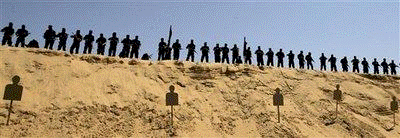
4/23/2007, 8:00 p.m. EDT
Palestinian militants from Islamic Jihad take part in a training session in the evacuated Jewish settlement of Netzarim, south of Gaza City, Tuesday, April 24, 2007. Hamas militants fired a barrage of rockets and mortar shells toward Israel on Tuesday and said they considered a five-month truce with Israel to have come to an end. (AP Photo/ Hatem Moussa)
In this photograph, the Palestinians appear black and faceless, as though a threatening, deviant force.
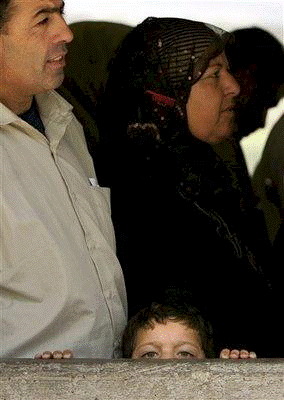
A young child peers over a barrier as Palestinians wait to cross the Hawara checkpoint near the West Bank city of Nablus, Tuesday, April 24, 2007. Israel imposed a full closure on the West Bank and Gaza Strip as the nation marks its annual Independence Day Tuesday. (AP Photo/Muhammed Muheisen)
In this photograph and caption, the Palestinians are being presented as people being led and controlled by Israeli forces, which to me implies the order that the military imposes, versus the deviant power portrayed in the previous photograph.
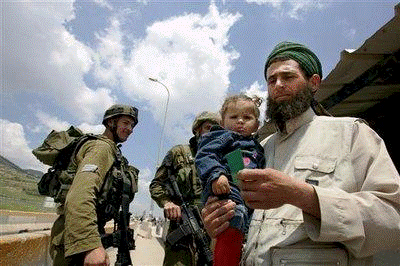
4/23/2007, 8:00 p.m. EDT
A Palestinian man holds his daughter as Israeli soldiers watch whilst he crosses the Hawara checkpoint near the West Bank city of Nablus, Tuesday, April 24, 2007. Israel imposed a full closure on the West Bank and Gaza Strip as the nation marks its annual Independence Day on Tuesday. (AP Photo/Muhammed Muheisen)
This photograph instantly reminded me of similar photographs I’ve seen of U.S. soldiers in Afghanistand and Iraq with the civilians. Again, it is a picture of military order prevailing. Furthermore, in this picture, Israeli soldiers look relatively peaceful or non-violent.
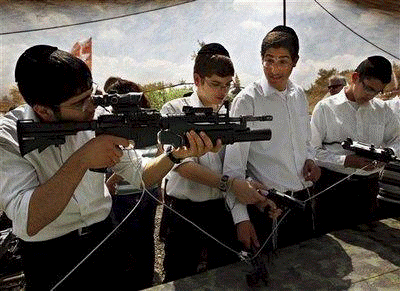
4/23/2007, 8:00 p.m.
Israeli Orthodox-Jewish youths look at weapons during a display by the army at Ammunition Hill as part of Independence Day celebrations in Jerusalem, Tuesday, April 24, 2007. Israel is celebrating its annual Independence Day, marking 59 years since the founding of the state in 1948. (AP Photo/Kevin Frayer)
This photograph struck me because I believe that it is likely that people would interpret this photograph differently than an identical picture of Palestinian children playing with guns. This is not a claim, but rather a question for people to honestly analyze their reactions to see if there is a difference and why.
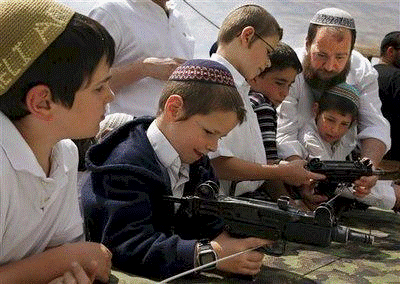
4/23/2007, 8:00 p.m. EDT
Israeli children look at weapons during a display by the army at Ammunition Hill as part of Independence Day celebrations in Jerusalem, Tuesday, April 24, 2007. Israel is celebrating its annual Independence Day, marking 59 years since the founding of the state in 1948. (AP Photo/Kevin Frayer)
The same comment applies to this photograph of Israeli children playing with guns. I would like to add that the look on the children’s faces is not one of hatred, but more like curiosity.
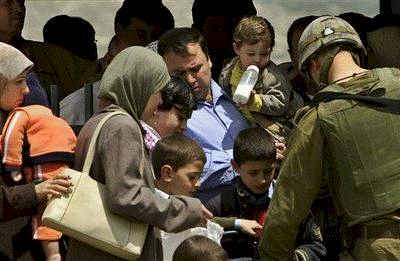
4/23/2007, 8:00 p.m. EDT
An Israeli soldier checks a Palestinian family as they wait to cross Hawara checkpoint near the West Bank city of Nablus, Tuesday, April 24, 2007. Israel imposed a full closure on the West Bank and Gaza Strip as the nation marks its annual Independence Day on Tuesday. (AP Photo/Muhammed Muheisen)
Again, this appears to be a photograph of a non-aggressive military maintaining order, which coincided with the framework of a Palestine that needs to be handled and “herded.”
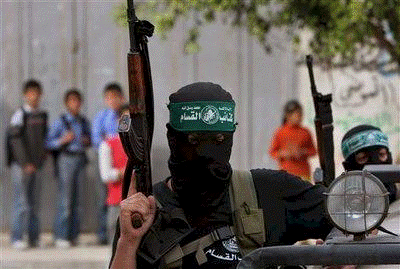
4/24/2007, 8:00 p.m. EDT
Masked Palestinian militants from Hamas carry their weapons during a rally by the group in the Shati Refugee Camp, Wednesday, in Gaza City, April 25, 2007. Israeli Prime Minister Ehud Olmert on Wednesday authorized the army to carry out limited operations in the Gaza Strip, but ruled out a large-scale ground offensive, officials said, a day after Hamas militants carried out rocket attacks on Israel from Gaza, jeopardizing a 5-month cease-fire. (AP Photo/Hatem Moussa)
I think many viewers would react very differently to this photograph than to an identical one where an Israeli soldier is holding a gun (without a mask though). In this picture, an image of fear/tyrrany and deviance is evoked, but if it were an Israeli soldier, it would likely evoke an image of maintaining order and legitimacy versus deviance.
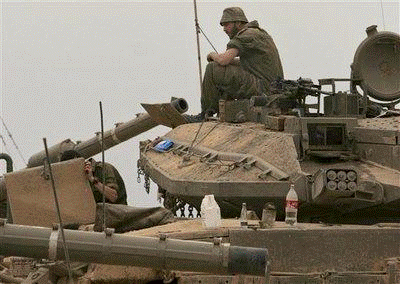
4/25/2007, 8:00 p.m. EDT Israeli soldiers sit atop tank next to the border between Israel and the Gaza Strip, Thursday, April 26, 2007. Palestinian militants in the Gaza Strip fired two rockets toward Israel on Thursday, the army said, further threatening a cease-fire strained by several days of fighting. Israeli Prime Minister Ehud Olmert on Wednesday ruled out a large-scale invasion of Gaza in response to a barrage of rockets fired by the Hamas militant group earlier in the week, giving a chance for the 5-month-old truce to take hold again. (AP Photo / Tsafrir Abayov)
Again, it is hard not to correlate this image with images of the U.S. military surveying an area and keeping order until a resolution materializes. If this is how many American viewers interpret this photograph, the framework of the parallel Israel and U.S. forces instills the connection of the two governments, creating the sense that Israel is more peace-seeking than Palestine.
The following two photographs serve as compare/contrast photos:
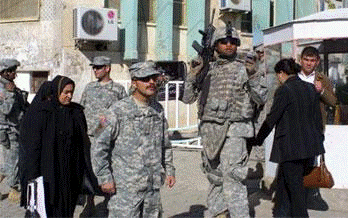
American soldiers in Sulaymaniyeh, northern Iraq, face little hostility from civilians. Nardin Baban, a Kurdish-American translator (foreground, without rifle), helps the other soldiers communicate with civilians. -Truth Digg Magazine Dec. 2006
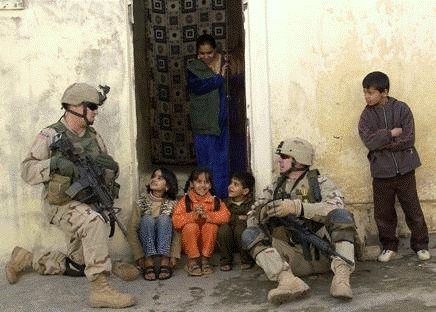
Picture of U.S. soldiers in Afghanistan with civilians.